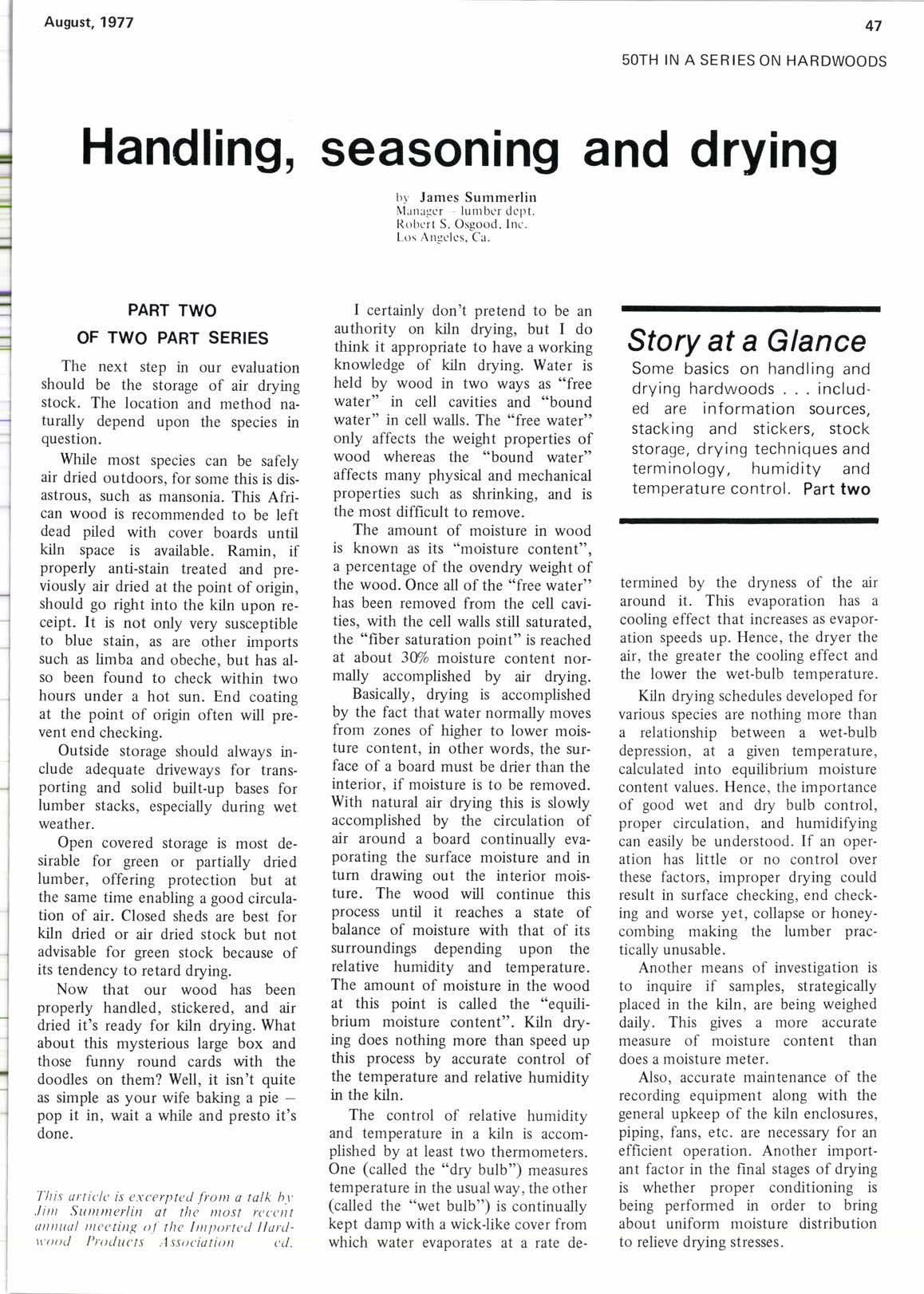
3 minute read
Handling, seasoning and drying
by, James Summerlin Illanrgcr - Iuntbcr dcpt. Robcrt S. Osgood. lnc. Los An!:clcs. Ca.
Part Two Of Two Part Series
The next step in our evaluation should be the storage of air drying stock. The location and method naturally depend upon the species in question.
While most species can be safely air dried outdoors, for some this is disastrous, such as mansonia. This African wood is recommended to be left dead piled with cover boards until kiln space is available. Ramin, if properly anti-stain treated and previously air dried at the point of origin, should go right into the kiln upon receipt. It is not only very susceptible to blue stain, as are other imports such as limba and obeche. but has also been found to check within two hours under a hot sun. End coating at the point of origin often will prevent end checking.
Outside storage should always include adequate driveways for transporting and solid built-up bases for lumber stacks, especially during wet weather.
Open covered storage is most desirable for green or partially dried lumber, offering protection but at the same time enabling a good circulation of air. Closed sheds are best for kiln dried or air dried stock but not advisable for green stock because of its tendency to retard drying.
Now that our wood has been properly handled, stickered, and air dried it's ready for kiln drying. What about this mysterious large box and those funny round cards with the doodles on them? Well, it isn't quite as simple as your wife baking a piepop it in, wait a while and presto it's done.
Tlri.s urtit'le is axcerptetl fron a talk b.t. ,littr Sutnnterlin at tltc ntosr rctcnt ttntrttul tttactittg ().l thc Intpot'tt'd Ilurdrr'ootl l'rodttt'ts ,l.ssttciation cd.
I certainly don't pretend to be an authority on kiln drying, but I do think it appropriate to have a working knowledge of kiln drying. Water is held by wood in two ways as "free water" in cell cavities and "bound water" in cell walls. The "free water" only affects the weight properties of wood whereas the "bound water" affects many physical and mechanical properties such as shrinking, and is the most difhcult to remove.
The amount of moisture in wood is known as its "moisture content", a percentage of the ovendry weight of the wood. Once all of the "free water" has been removed from the cell cavities, with the cell walls still saturated, the "fiber saturation point" is reached at about 307a moisture content normally accomplished by air drying.
Basically, drying is accomplished by the fact that water normally moves from zones of higher to lower moisture content, in other words, the surface of a board must be drier than the interior, if moisture is to be removed. With natural air drying this is slowly accomplished by the circulation of air around a board continually evaporating the surface moisture and in turn drawing out the interior moisture. The wood will continue this process until it reaches a state of balance of moisture with that of its surroundings depending upon the relative humidity and temperature. The amount of moisture in the wood at this point is called the "equilibrium moisture content". Kiln drying does nothing more than speed up this process by accurate control of the temperature and relative humidity in the kiln.
The control of relative humidity and temperature in a kiln is accomplished by at least two thermometers. One (called the "dry bulb") measures temperature in the usual way, the other (called the "wet bulb") is continually kept damp with a wick-like cover from which water evaporates at a rate de-
Story at a Glance
Some basics on handling and drying hardwoods . . . included are information sources, stacking and stickers, stock storage, drying techniques and terminology, humidity and temperature control. Part two termined by the dryness of the air around it. This evaporation has a cooling effect that increases as evaporation speeds up. Hence, the dryer the air, the greater the cooling effect and the lower the wet-bulb temperature.
Kiln drying schedules developed for various species are nothing more than a relationship between a wet-bulb depression, at a given temperature, calculated into equilibrium moisture content values. Hence, the importance of good wet and dry bulb control, proper circulation, and humidifying can easily be understood. If an operation has little or no control over these factors, improper drying could result in surface checking, end checking and worse yet, collapse or honeycombing making the lumber practically unusable.
Another means of investigation is to inquire if samples, strategically placed in the kiln, are being weighed daily. This gives a more accurate measure of moisture content than does a moisture meter.
Also, accurate maintenance of the recording equipment along with the general upkeep of the kiln enclosures, piping, fans, etc. are necessary for an efficient operation. Another important factor in the final stages of drying is whether proper conditioning is being performed in order to bring about uniform moisture distribution to relieve drying stresses.










